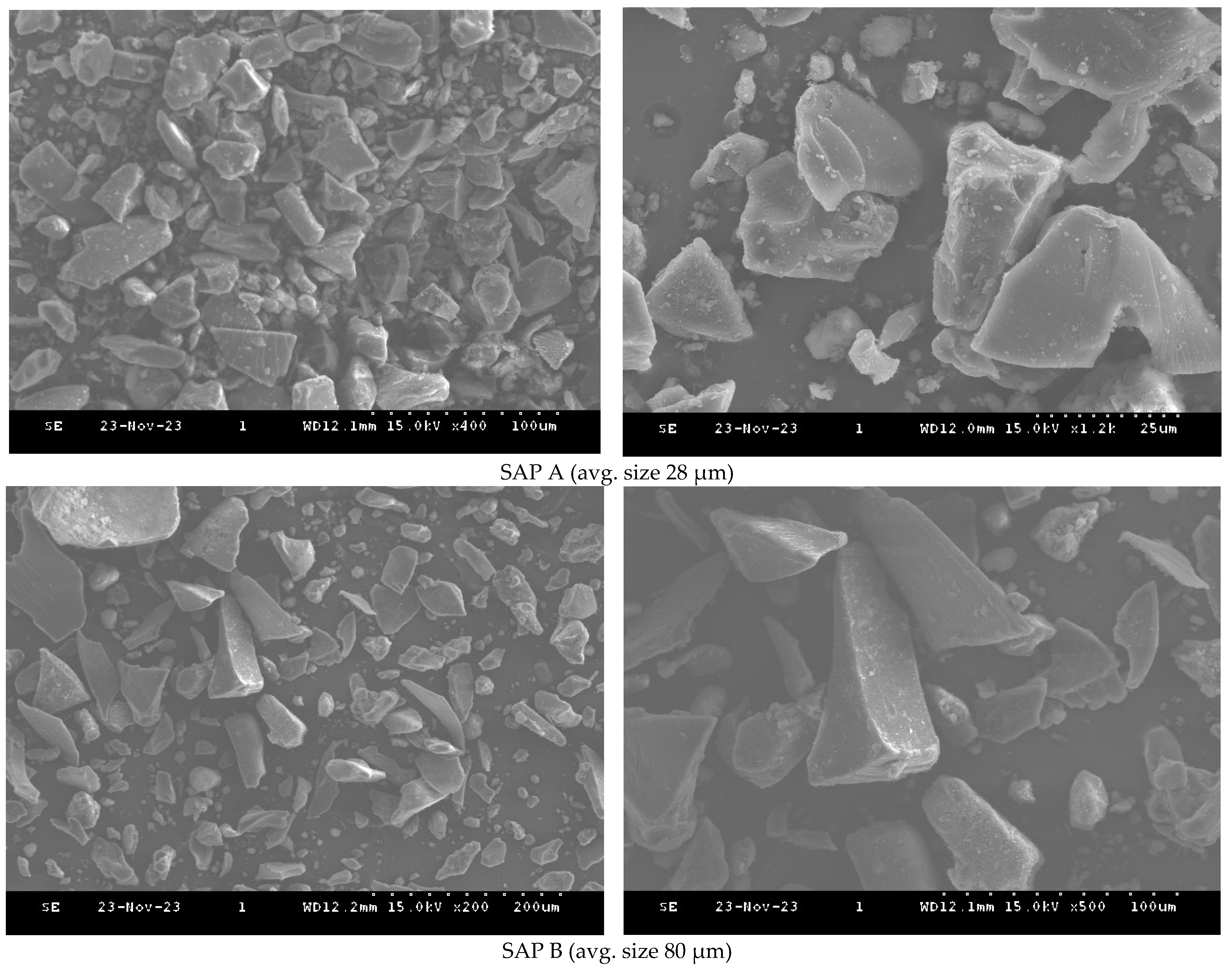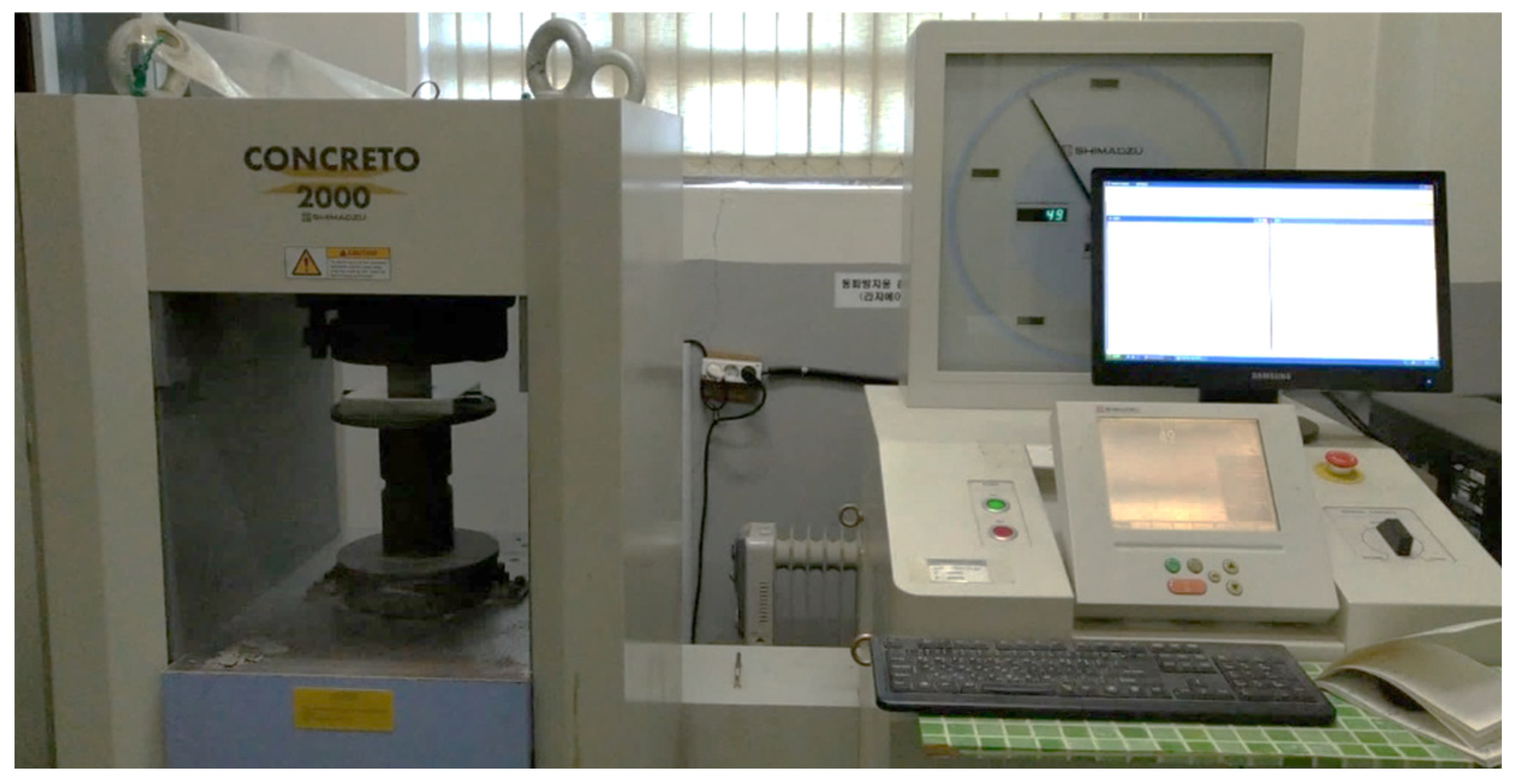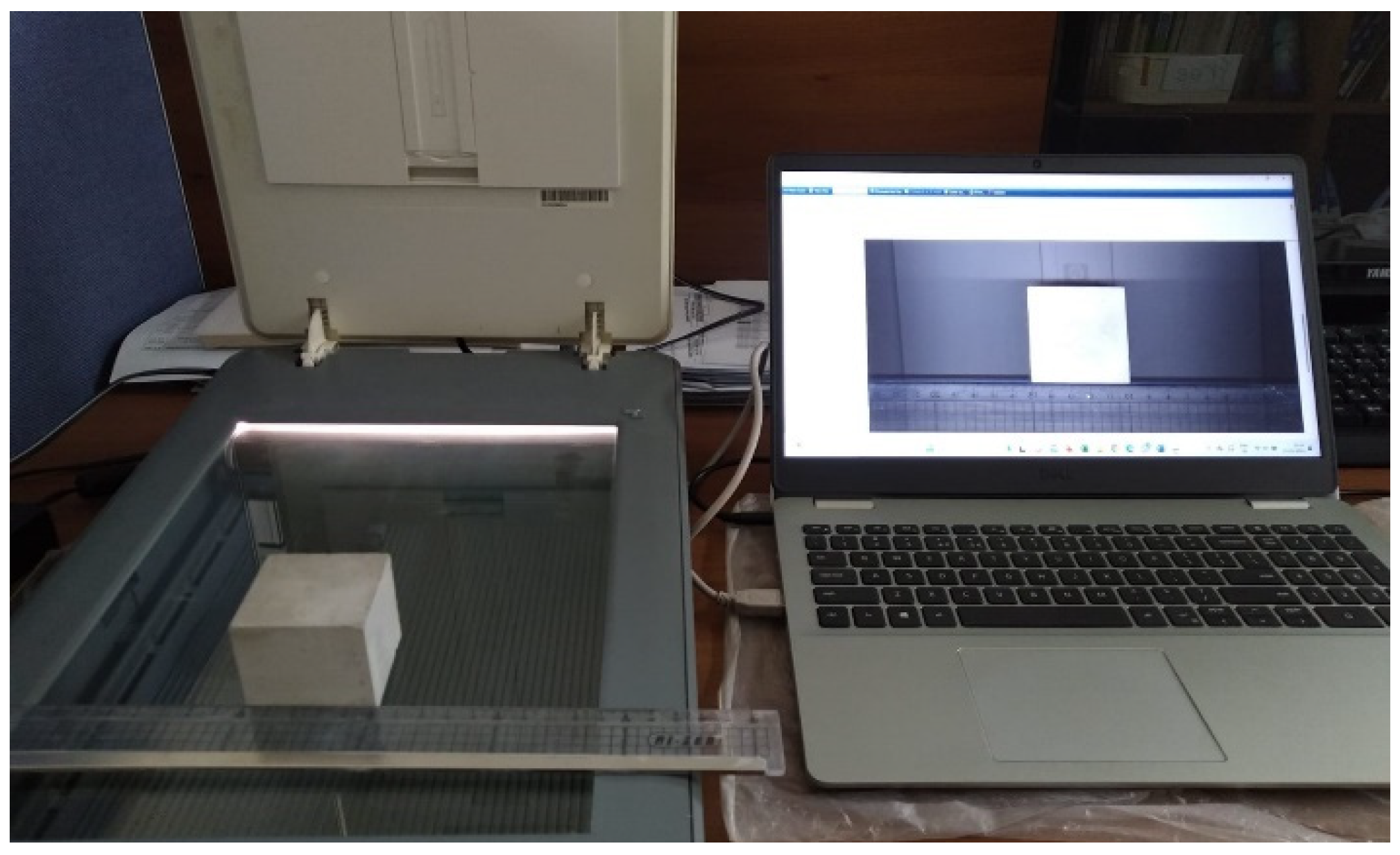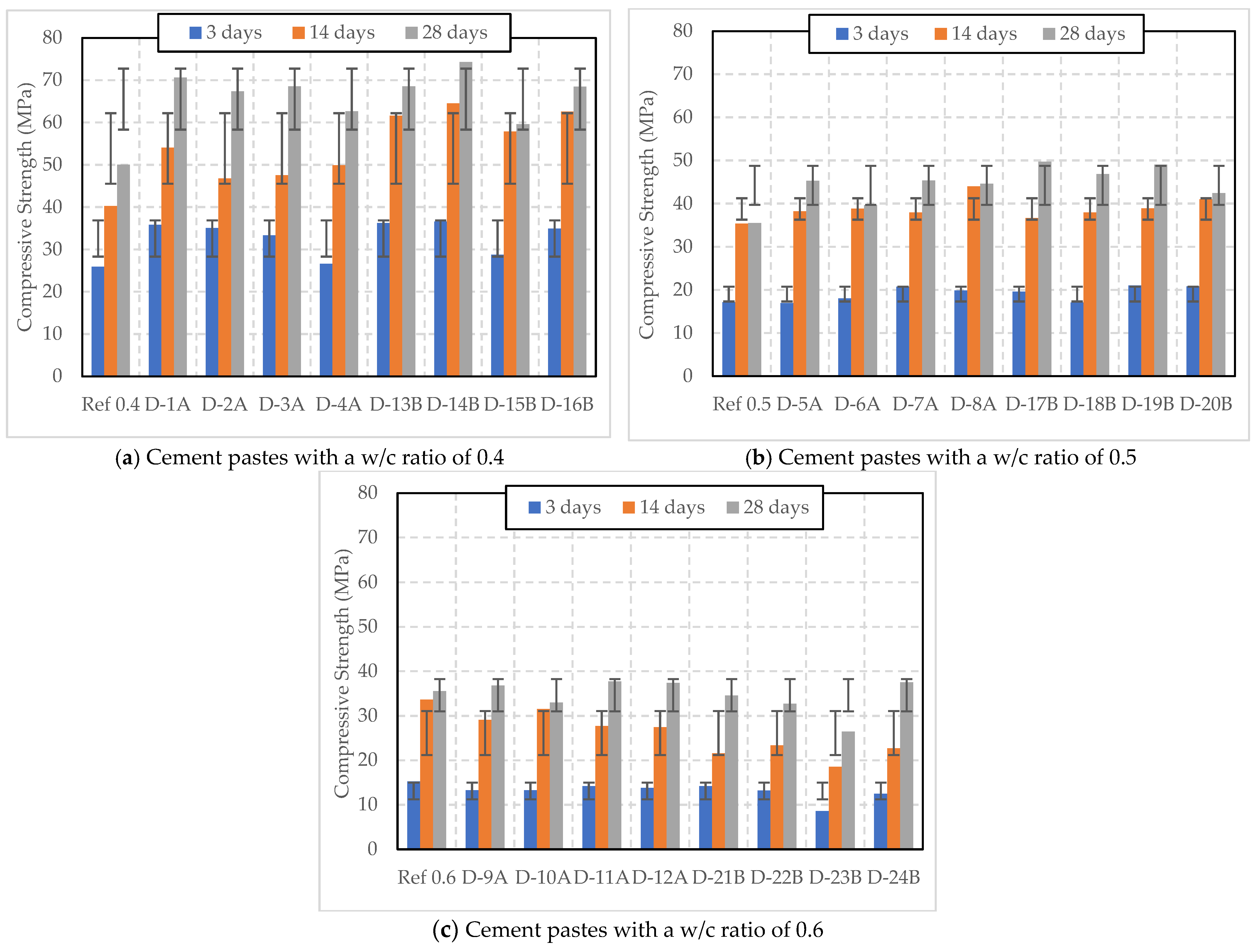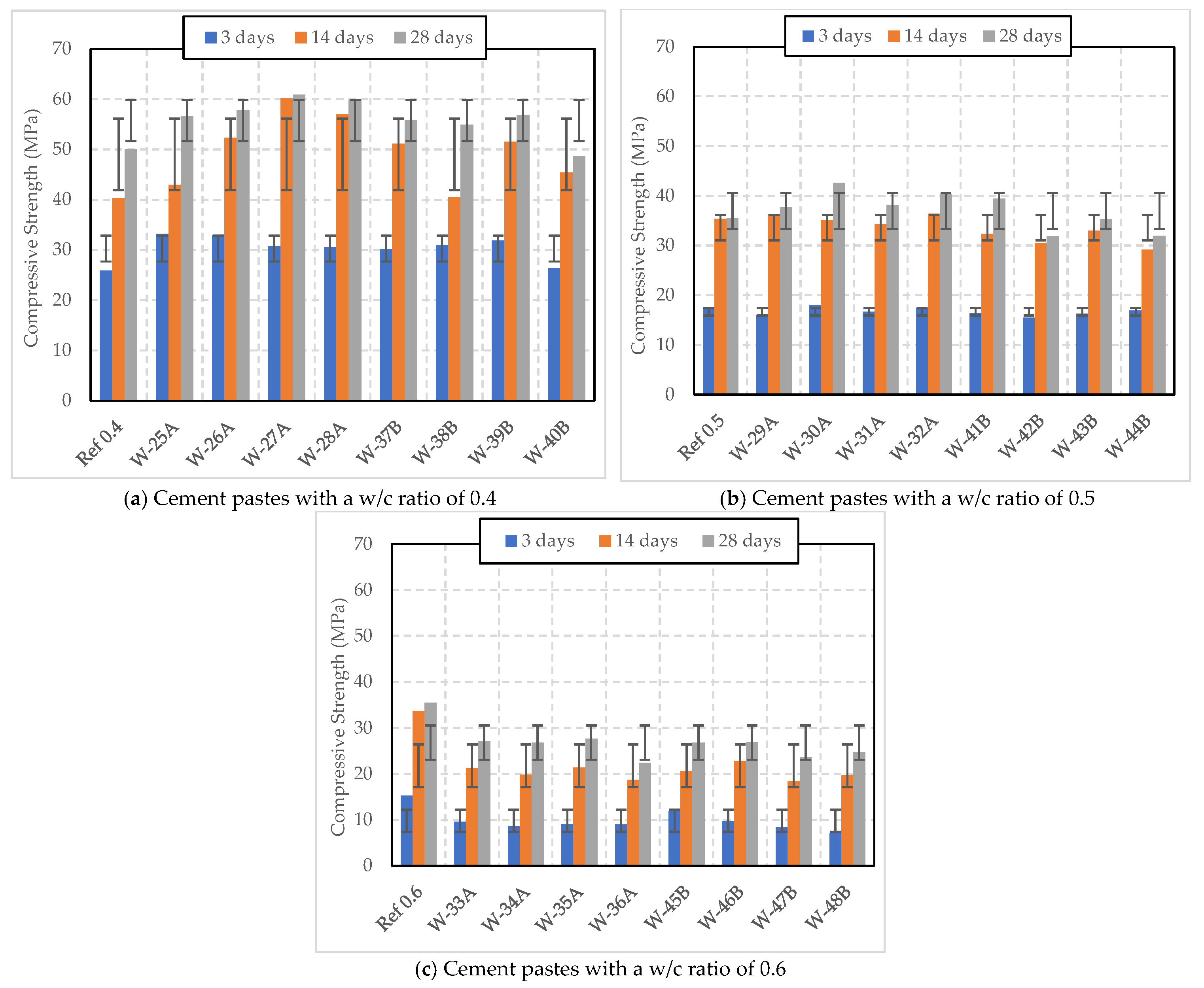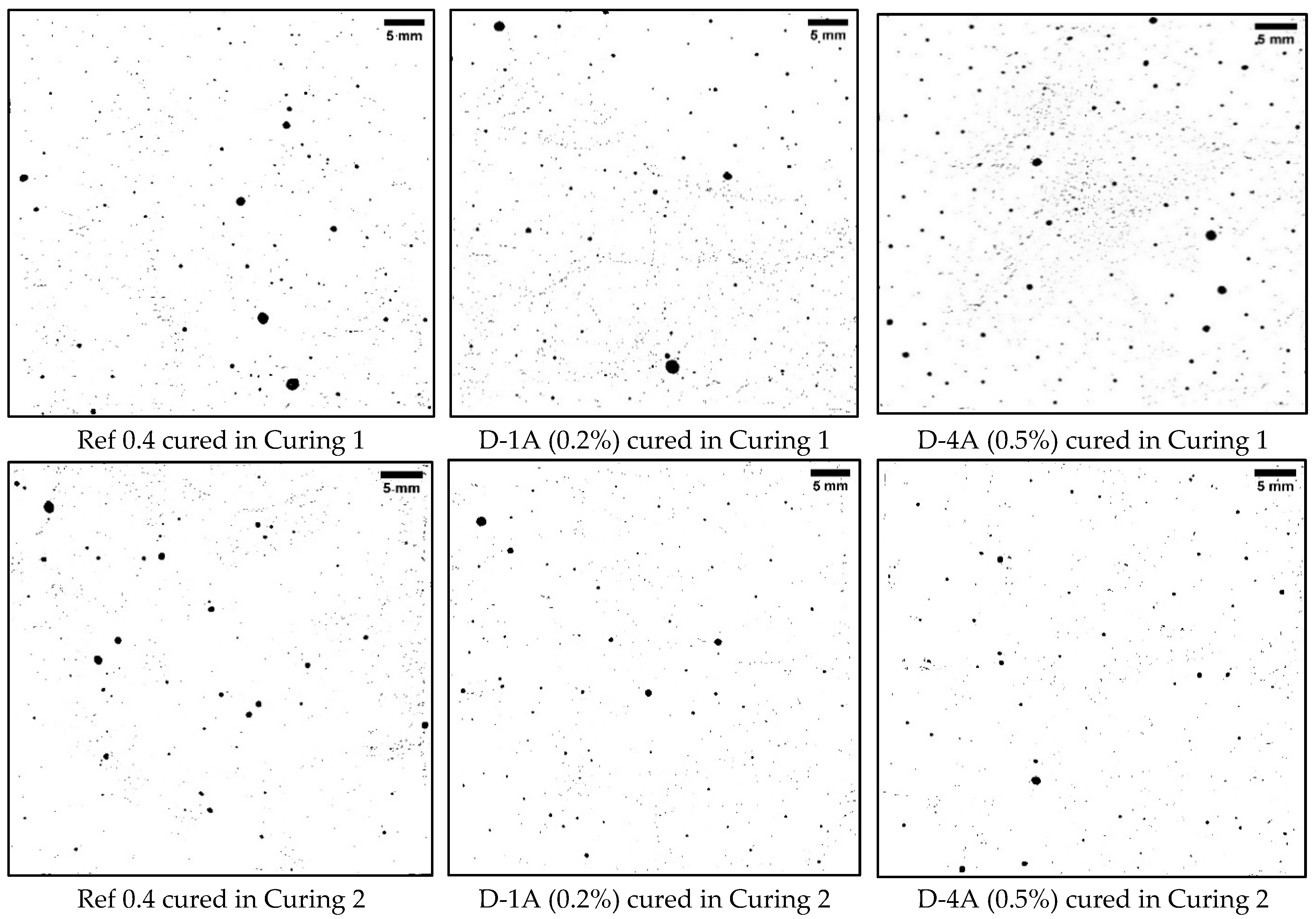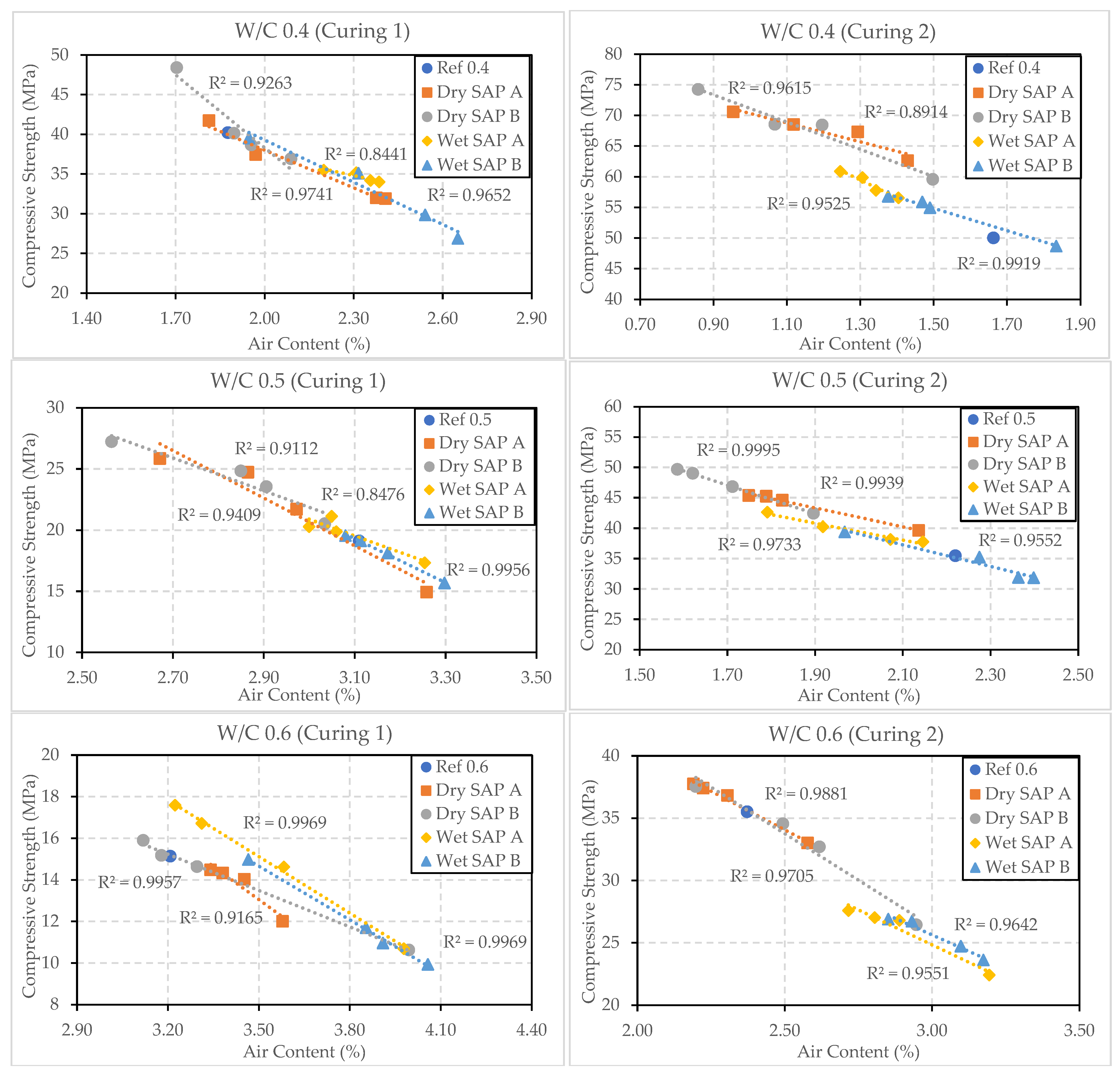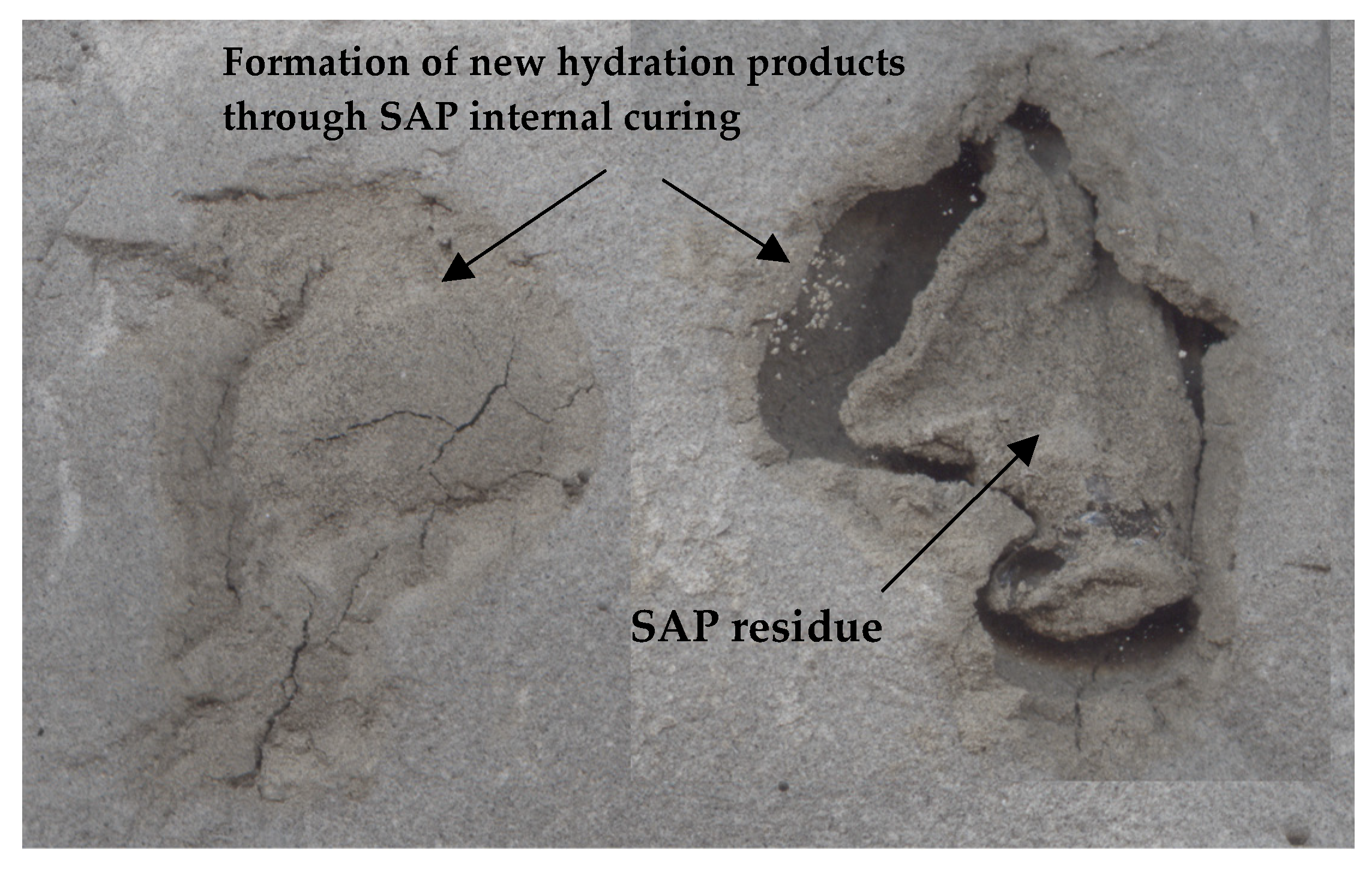3.1. Compressive Strength
Figure 5 presents the compressive strength of cement pastes with different w/c ratios (0.4, 0.5, and 0.6) and varying dosages of dry SAP A and B (0.2–0.5% by weight of cement), cured under Curing 1 conditions. In
Figure 5a, it is evident that the addition of dry SAP decreased the strength compared to the reference sample with a w/c ratio of 0.4 in most of the samples. However, samples with 0.2% SAP A (D-1A), 0.2% SAP B (D-13B), and 0.4% SAP B (D-16B) exhibited higher strength than the reference sample without SAP. Specifically, D-1A recorded an early compressive strength of 28.93 MPa at 3 days that slightly increased to 41.73 MPa at 28 days. Notably, D-16B showed exceptional strength growth compared to the other samples, with an initial strength of 30.35 MPa at 3 days and an outstanding final strength of 48.4 MPa at 28 days, indicating that a 0.5% dosage of SAP B significantly enhances the cement’s compressive strength over time under Curing 1 conditions. On the other hand, D-13B initially reached 31.6 MPa but had a slightly lower strength of 40.13 MPa at 28 days compared to the reference. When a 0.3% SAP dosage was used, D-2A showed higher initial strength compared to D-14B, but its strength decreased over time, while that of D-14B consistently increased. Similarly, D-3A had higher initial strength than D-15B, but lower strength after 28 days. Higher dosages of SAP A above 0.3% led to a reduction in compressive strength compared to the reference sample. This aligns with a study by Huang et al. (2022) [
26], which found that, as the SAP dosage increased, the compressive strength initially increased and then decreased. This may be attributed to water absorption by SAP during mixing, which reduces the effective w/c ratio and increases strength. Additionally, the voids (macro-pores) created by the water absorbed by the SAP can further decrease the compressive strength [
3,
26].
As the w/c ratio increased, the compressive strength decreased. In
Figure 5b, the cement pastes with a w/c ratio of 0.5 and cured under Curing 1 conditions showed a reduction in 28-day compressive strength. This strength was lower than the 14-day compressive strength for all samples, except for D-6A, which showed an increase from 18.39 MPa at 3 days to 23.89 MPa at 14 days, and 24.73 MPa at 28 days. D-5A with the lowest dosage of SAP A exhibited the weakest performance, even lower than the reference sample, with a 28-day strength of 14.93 MPa. D-7A, with 0.4% SAP A, showed a higher initial strength of 19.74 MPa and the highest 14-day strength of 27.78 MPa, which decreased to 25.85 MPa at 28 days. In contrast to this study, Beushausen et al. (2014) [
27] found that adding SAP to mortar with a water-to-binder ratio of 0.55 led to a slight decrease in early-age compressive strength, which partially recovered over time with internal curing.
Among the samples with SAP B, D-19B with a 0.4% dosage exhibited the highest initial strength of 21.65 MPa and the highest 14-day strength of 33.65 MPa, across all samples with SAP B, but this decreased to 27.23 MPa at 28 days. Conversely, D-18B with a 0.3% dosage of SAP B showed lower strengths at all stages compared to other mixes with SAP B.
In
Figure 5c, it can be observed that the cement pastes with a w/c ratio of 0.6 and varying dosages of SAP A under Curing 1 conditions showed lower compressive strength compared to the reference sample. D-22B and D-24B with 0.3% and 0.5% SAP B dosages, respectively, exhibited higher 28-day compressive strength of 15.9 MPa and 15.18 MPa compared to the reference sample strength of 15.14 MPa. D-21B showed a minimal reduction in compressive strength compared to the reference sample. On the other hand, D-23B with a 0.4% SAP dosage showed the lowest compressive strength among all the samples.
From
Figure 6a, it can be observed that mixes with a w/c ratio of 0.4 and cured under Curing 2 conditions exhibited increased compressive strength for all samples containing SAP A and SAP B, compared to the reference sample without SAP. The reference sample achieved strengths of 25.90 MPa, 40.28 MPa, and 50.03 MPa at 3, 14, and 28 days respectively. Incorporating 0.2% SAP A (D-1A) significantly increased strengths to 35.81 MPa, 54.05 MPa, and 70.59 MPa at the respective ages. However, a higher dosage of 0.3% SAP A (D-2A) did not appreciably increase the 28-day strength compared to the 0.2% dosage, but showed lower strengths at earlier ages. With 0.4% SAP A (D-3A), the strengths were further reduced at early ages compared to the 0.2% dosage but slightly increased at 28 days. The higher dosage of 0.5% SAP A (D-4A) resulted in early strength loss, such as 26.63 MPa (at 3 days) and 49.85 MPa (at 14 days), with only a marginal increase at 28 days (62.6 MPa) compared to D-1A. Similarly, increasing strengths were observed with 0.2% and 0.3% SAP B (D-13B and D-14B), achieving the highest 28-day strengths of 68.54 MPa and 74.25 MPa, respectively. However, a higher dosage of 0.4% SAP B (D-15B) and 0.5% SAP B (D-16B) reduced compressive strength at all ages compared to the D-13B and D-14B samples.
Both dry SAP A and SAP B led to increased compressive strength at optimal dosages. SAP B dosed at 0.3% (D-14B) resulted in the highest 28-day compressive strength observed, outperforming all SAP A and B dosages. While some SAP additions can improve strength, they must be dosage-constrained, because excessive SAP can reduce compressive strength at certain curing ages.
Figure 6b presents the compressive strengths of cement paste samples with a w/c ratio of 0.5, incorporating varying dosages of SAP and cured under Curing 2 conditions. The reference sample without SAP displayed compressive strengths of 17.13 MPa (3 days), 35.36 MPa (14 days), and 35.48 MPa (28 days), respectively. All samples containing SAP performed well compared to the sample without SAP.
Adding 0.2% SAP A (D-5A) led to a slight decrease in early strength at 3 days (16.96 MPa), but eventually showed improvement over the reference sample at later ages, with the 28-day strength reaching 45.24 MPa. Increases at 0.3% SAP A (D-6A) were marginal across all ages, while the more considerable increase in early strength at 3 days for the 0.4% SAP A (D-7A) dosage was substantial, maintaining a higher 28-day strength of 45.36 MPa as well. The 0.5% SAP A dosage (D-8A) also showed improvement over the reference at 14 and 28 days, but this was less pronounced than the 0.4% dosage.
When considering SAP B, even the lowest dosage of 0.2% (D-17B) demonstrated a significant increase in both early and late strengths, reaching a peak of 49.67 MPa at 28 days. A dosage of 0.3% (D-18B) resulted in a strength increase at 28 days, although it was lower than the 0.2% dosage. The highest early strength of 21.04 MPa was exhibited by the 0.4% dosage (D-19B), and it also had an increased strength of 49.01 MPa at 28 days, which was close to that of the 0.2% dosage. However, the 0.5% dosage (D-20B) did not achieve this maximum, especially at 28 days. The effectiveness of SAP additions appeared to peak at different dosage levels for SAP, with SAP B at 0.2% and 0.4% dosages resulting in the highest 28-day strength.
From
Figure 6c, it can be observed that the SAP A series (D-9A to D-12A), ranging from 0.2% to 0.5% dosages, showed a slight decrease in early strength at 3 days compared to the reference. However, all dosages showed some improvement in strength at 28 days, with 0.4% SAP A showing the highest increase to 37.74 MPa.
For the SAP B series (D-21B to D-24B), the 0.2% dosage showed a slight reduction in strength at 14 days but improved at 28 days (34.55 MPa), although slightly less than the reference. Increasing the SAP B dosage to 0.3%, 0.4%, and 0.5% resulted in further reductions in early and middle-age strengths. Remarkably, the 0.5% dosage of SAP B (D-24B) did show a notable increase at 28 days, finishing with the highest strength of 37.53 MPa among all SAP B samples. Overall, while initial strengths were generally lower for paste samples containing SAP, several configurations displayed improved 28-day compressive strengths, suggesting a nuanced relationship between SAP dosage and cement strength development, with potential benefits at certain dosages and curing times.
Overall, it is clear that the use of dry SAP in cement paste samples, cured under Curing 1 conditions, generally resulted in a decrease in compressive strength in most cases. In contrast, under Curing 2 conditions (water curing), a consistent increase in strength was observed in many cases, suggesting that water curing effectively enhanced the strength of dry SAP-modified cement pastes.
Figure 7 and
Figure 8 illustrate the compressive strength of cement pastes with varying w/c ratios and dosages of wet SAP, cured under Curing 1 and Curing 2 conditions. In
Figure 7a, all samples with wet SAP A exhibited a reduction in compressive strength compared to the reference. The inclusion of wet SAP A helped increase strength at 3 and 14 days compared to the reference, but it had an impact on the 28-day strength development.
On the other hand, the introduction of wet SAP B resulted in a reduction in compressive strength as the SAP dosage increased from 0.3%. At a dosage of 0.2% SAP B, the sample surpassed the reference with a 28-day strength of 39.53 MPa, slightly lower than the reference. However, the inclusion of wet SAP B led to a continuous increase in strength, which was contrary to the results observed with SAP A.
In
Figure 7b, at a dosage of 0.2% SAP, sample W-29A exhibited strengths of 18.35 MPa at 3 days, 22.89 MPa at 14 days, and 19.89 MPa at 28 days. In contrast, W-41B showed strengths of 14.16 MPa at 3 days, 18.19 MPa at 14 days, and 19.56 MPa at 28 days. This indicates that SAP A leads to higher early strength development than SAP B, although by 28 days the strengths are relatively similar. W-41B showed continuous development in strength, which was opposite to W-29A. However, higher doses of SAP A, such as 0.3% and 0.4% (W-30A and W-31A), resulted in lower early strengths at 3 and 14 days. Nevertheless, the 0.4% SAP A sample slightly surpassed the reference at 28 days with a strength of 20.3 MPa. Higher doses of wet SAP A led to a slight increase in compressive strength over time, reaching 21.13 MPa at 28 days compared to the reference. Sample W-43B demonstrated higher initial strength development, starting at 15.51 MPa at 3 days and ending at 18.14 MPa at 28 days, which was lower than W-31A and the reference. On the other hand, W-44B had the lowest strengths among all measured ages, compared to the other samples. According to a study conducted by Kong et al. (2014), the inclusion of pre-soaked SAP marginally diminished compressive strength, particularly noticeably in early-age concrete. However, this can be mitigated by selecting an appropriate dosage of SAP [
28].
In
Figure 7c, both W-33A and W-34A initially had strengths comparable to the reference, but surpassed it by 28 days, reaching 17.59 MPa and 16.71 MPa, respectively, indicating better performance over time. W-35A (0.4% dosage) strength started just below the reference and showed a significant drop at 14 days before slightly recovering to 14.63 MPa at 28 days. W-36A, which contained a higher dosage (0.5%), consistently had lower strength throughout the testing period, with the lowest 28-day strength among all SAP A samples at 10.69 MPa.
All the samples containing SAP B resulted in a decrease in strength over time compared to samples with SAP A and the reference. Sample W-45B exhibited higher early strength than the reference, peaking impressively at 16.58 MPa at 14 days but experiencing a sharp decline to 10.96 MPa at 28 days. W-46B (0.3% dosage) had the lowest initial strength but demonstrated substantial gain by 14 days; however, it decreased to 14.98 MPa at 28 days. The higher dosage of SAP B, W-47B and W-48B, showed lower compressive strength at all intervals compared to the other samples.
Figure 8 demonstrates that the addition of wet SAP to cement paste, cured under Curing 2 conditions, enhances compressive strength compared to the reference sample without SAP. In
Figure 8a, W-25A with 0.2% wet SAP A consistently surpasses the reference sample at all stages, indicating the beneficial effect of this SAP on compressive strength; it reached a strength of 56.55 MPa at 28 days. W-26A shows the most significant increase in strength over time, starting at 32.96 MPa and reaching the highest strength of 57.79 MPa at 28 days. The SAP A series (W-25A to W-28A) demonstrates a trend where compressive strength improves with increasing SAP dosages up to 0.4%. W-27A achieved the highest 28-day strength at 60.89 MPa. W-28A shows a slight decline compared to the 0.4% dosage but still outperformed the reference sample, reaching 59.88 MPa at 28 days.
W-37B exhibited higher initial strength compared to the reference and maintained higher strength at 28 days, reaching 55.89 MPa. W-38B and W-39B, with 0.3% and 0.4% wet SAP B, respectively, showed increased strength over time, while W-40B with 0.5% exhibited the lowest compressive strength at 28 days among the wet SAP B series and the reference sample.
Figure 8b shows that the addition of wet SAP A leads to an increase in strength over time, while wet SAP B results in a decrease with increasing dosage. W-29A initially had lower 3-day strength than the reference but slightly surpassed it with a strength of 37.79 MPa at 28 days. W-30A had higher initial strength than the reference that continued to develop, resulting in the highest strength at 28 days (42.63 MPa) among all samples. W-31A started with lower 3-day strength but then followed an upward trend, reaching a 28-day strength of 38.16 MPa. W-32A maintained high strength throughout the test period, ending with a robust 40.26 MPa at 28 days, consistently improving over the reference sample.
W-41B initially started slightly below the reference in terms of initial strength but exhibits the highest 28-day strength of 39.4 MPa among the SAP B series. W-42B (0.3% dosage) has lower strength at all stages compared to the reference, with a notable drop, concluding with 31.86 MPa at 28 days. W-43B shows an increasing trend in strength, although reaching only 35.25 MPa at 28 days, slightly below the reference. The sample W-44B (0.5% dosage) reflected improvement between 3 and 14 days but then displayed decreasing strength, ending with 31.9 MPa at 28 days, the lowest overall among the SAP B samples.
From
Figure 8c, it can be observed that all cement paste samples with a w/c of 0.6 and SAP displayed lower compressive strengths throughout the curing process compared to the reference sample without SAP. This indicates that higher dosages of wet SAP A & B and a higher w/c ratio may have a negative impact on strength development. Interestingly, within the SAP A series, samples W-33A and W-35A achieved the highest 28-day strengths, at 27.03 MPa and 27.59 MPa, respectively. However, these strengths were still lower than that of the reference sample. Notably, the sample with the highest SAP A dosage, W-36A (0.5% SAP A), consistently exhibited the lowest compressive strengths throughout all testing periods. This suggests that higher dosages of SAP A do not necessarily result in better strength outcomes when samples are prepared with a w/c ratio of 0.6 and cured under Curing 2 conditions.
Similarly, like SAP A, all SAP B samples demonstrated lower compressive strength values compared to the reference sample at all recorded times. Among the SAP B series, W-46B (0.3% SAP B) achieved the highest 28-day strength at 26.9 MPa. However, this value still falls below that of the reference sample. W-48B (0.5% SAP B) showed a trend of increasing compressive strength over time but consistently fell short of the reference sample at each interval, with a 28-day strength of 24.73 MPa. This indicates that a higher content of SAP B may not be beneficial in terms of strength development.
The observed differences in performance among the samples suggest that the dosage of SAP and the curing conditions have a significant impact on the development of compressive strength. Therefore, it is crucial to optimize the SAP dosage and curing conditions to achieve the desired strength characteristics in cement paste. Cement paste cured under Curing 1 conditions (temperature of 20 °C and 60% RH) resulted in a decrease in strength after 14 days. However, the use of Curing 2 conditions (water curing) yielded positive results when used with cement paste containing SAP A and SAP B. This is in contrast to a study conducted by Sun et al. (2019), which found that water curing decreased strength, while air curing enhanced the later-age strength of cement mortar and concrete [
15]. Furthermore, the inclusion of dry SAP resulted in higher compressive strength development compared to the addition of wet SAP. Similar findings were reported by Tan et al. (2019), who discovered that the addition of dry SAP increased the 28-day compressive strength by approximately 10–50%, whereas wet SAP resulted in a strength increase ranging from -26% to 6% [
20].
3.2. Void Analysis by ImageJ
The scanned images of the samples cured for 28 days were processed using ImageJ software (version 1.54h). Two images were processed for each sample. The specific surface area (SSA) and spacing factor were then calculated based on the equations suggested by [
29,
30,
31]. The specific surface of air voids in concrete measures their total surface area relative to their volume. According to ASTM C457 [
32], a specific surface range of 23.6 to 43.3 mm
−1 is recommended for concrete to resist damage from freeze–thaw cycles. Higher values indicate a finer distribution of air voids [
31,
32]. The spacing factor, defined by Power, is a parameter related to the maximum distance of any point in the cement paste from the periphery of an air void [
29]. It is the primary indicator of the air void system’s ability to withstand frost attack, with around 0.200 mm suggesting effective frost resistance [
29,
31]. Furthermore, the air content is equal to the percentage of area occupied by air voids, as obtained from image analysis [
29].
Table 3,
Table 4,
Table 5,
Table 6,
Table 7 and
Table 8 depict the void analysis in cement paste with varying w/c ratios and SAP dosages (dry and wet) cured under Curing 1 and Curing 2 conditions. From
Table 3, it can be observed that cement paste with SAP A showed a range of total air content from 1.81% to 2.41%, while that of paste with SAP B ranged from 1.70% to 2.65%. Sample W-40B (0.5% SAP) exhibited the highest total air content of 2.65%. On the other hand, samples W-27A (0.4% SAP) and W-28A (0.5% SAP) exhibited significantly lower percentages of air voids under 1 mm, suggesting a smaller proportion of fine air bubbles and a higher proportion of larger bubbles compared to other samples. Generally, the SSA was higher in most of the samples with dry SAP A compared to SAP B; samples D-3A and D-15B had particularly high SSAs. In samples with wet SAP A, the SSA was lower than in samples with wet SAP B. Cement paste containing dry SAP A cured under Curing 1 conditions tended to have lower spacing factors overall, indicating closer spacing of air voids, which could have impacted the performance characteristics of the cement paste. Overall, samples with dry SAP A tended to have slightly higher air content, higher SSA, and lower spacing factors compared to samples with dry SAP B. On the other hand, samples with wet SAP A resulted in higher air content, higher spacing factors, and lower SSA compared to samples with wet SAP B. Additionally, wet SAP resulted in higher total air content compared to dry SAP mixes.
Figure 9 illustrates the cumulative air content in cement paste with a w/c ratio of 0.4. The paste contained different dosages of wet and dry SAP A and B and was cured under Curing 1 conditions. It is observed that the paste containing wet SAP has larger voids exceeding 1 mm in size. These larger voids are mostly observed in mixes with SAP A, which can be explained by the gel-blocking effect. This effect occurs when fine SAP particles (size less than 100 µm) come into contact with liquid, resulting in minimal absorption on their surface. As a result, the particles slightly swell and stick together, forming clusters consisting of both swollen and unswollen particles. This hinders further disaggregation and absorption [
10,
32,
33]. On the other hand, the cement pastes with dry SAP showed a higher number of smaller voids under 1 mm compared to the cement paste with wet SAP and without SAP. Samples D-2A and D-3A have a similar void system, while D-4A has a greater number of finer voids ranging from 0.01 to 0.07 mm. Additionally, among all the samples containing wet and dry SAP, W-27A (0.4%) and W-28A (0.5%) have fewer smaller voids, but a smaller number of larger voids ranging from 1 to 14 mm are present.
Upon comparing the above findings with the data presented in
Table 4, it is clear that Curing 2 (water curing) conditions led to a reduction in voids and an enhancement in strength. All samples subjected to Curing 2 conditions had an air content of less than 2%, with sample W-40B exhibiting the highest air content at 1.83% and a standard deviation of 0.09. This variation in air content suggests differences among the samples. It is worth noting that the samples with dry SAP had lower air content compared to samples with wet SAP, and the reference sample, D-1A, had the lowest air content at 0.95%. Additionally, sample D-4A, which had the highest dosage of SAP A, exhibited the highest SSA of 91.09 mm
−1. Conversely, sample D-16B, which had a higher SAP B dosage, had the lowest SSA of 44.46 mm
−1 among the SAP A and B samples. Furthermore, the samples with dry SAP B displayed a slightly higher spacing factor compared to the other mixes, with D-16B having the highest spacing factor at 0.25 mm. On the other hand, the samples with dry SAP A displayed a higher spacing factor compared to samples with wet SAP A.
Figure 10 and
Figure 11 illustrate the differences in the air void system resulting from the two curing conditions and the addition of dry and wet SAP. In the binary images, black indicates voids, while white represents the cement paste.
Figure 11 clearly illustrates the impact of Curing 1, Curing 2, and wet SAPs on the void system. The presence of wet SAP A and its gel-blocking effect can account for the larger voids observed in the W-27A sample. Furthermore, the voids in samples containing wet SAP A were significantly larger compared to those with wet SAP B.
Table 5 presents the void analysis data for cement paste with a w/c ratio of 0.5, as well as wet and dry SAP samples that were cured under Curing 2 conditions. It is evident that, among the SAP A samples, D-5A exhibits the highest total air content at 3.26%, followed closely by W-44B at 3.30% among the SAP B samples. However, the SAP A mixes resulted in lower total air content compared to the SAP B and reference mixes. Similarly, samples D-5A, D-18B, W-30A, W-41B, and W-44B have the highest percentage of air voids ≤ 1 mm, indicating the presence of finer air voids in these samples. Additionally, D-8A and W-44B have the highest SSAs among the dry and wet SAP samples, measuring at 79.05 mm
−1 and 61.27 mm
−1, respectively. Furthermore, D-5A and D-8A have the smallest spacing factor among the dry samples, measuring at 0.09 mm. Conversely, among the wet SAP samples, W-44B has the smallest spacing factor, measuring 0.11 mm.
Table 6 indicates void analysis data for cement paste with a w/c ratio of 0.5 and varying SAP dosages cured under Curing 2 conditions. The D-6A and W-29A samples, which contained dry and wet SAP A, exhibited the highest total air content at 2.14% and 2.15%, respectively. Comparatively, the reference sample had an air content of 2.22%. Similarly, the D-20B and W-42B samples showed the highest air content at 1.90% and 2.40%, respectively. The samples containing dry SAP and no SAP had more fine voids under 1 mm compared to the samples with wet SAP. Among the samples containing SAP A, D-8A had the highest SSA at 90.13 mm
−1 and a lower spacing factor at 0.10 mm. The D-19B sample, on the other hand, showed a higher SSA, at 78.11 mm
−1, among the cement pastes containing SAP B.
Table 7 presents void analysis data for cement paste with a w/c ratio of 0.6, cured under Curing 1 conditions. The air content for all the samples is above 3%, with D-23B, W-36A, and W-48B having the highest air contents, at 3.99%, 3.98%, and 4.06%, respectively, compared to the other samples. Among all the samples, W-48B showed exclusively fine voids under 1 mm in size, indicating a higher prevalence of fine voids. The D-23B samples displayed a higher SSA at 88.57 mm
−1, while W-33A exhibited the lowest SSA at 55.91 mm
−1. Furthermore, samples containing dry SAP showed a lower spacing factor compared to the reference and wet SAP samples.
From
Table 8, it is evident that the total air content decreased in Curing 2 compared to Curing 1. The dry and wet SAP A samples had higher total air contents, at 2.58% and 3.19%, respectively, in D-10A and W-36. Among the SAP B samples, D-23B exhibited a higher total air content, at 2.95%, while W-47B had 3.17%. Samples containing 0.3% to 0.5% of dry SAP A and B showed a finer void structure under 1 mm. Among dry and wet SAP samples, D-24B and W-36A had the lowest SSAs, at 64.68 mm
−1 and 60.80 mm
−1, respectively. On the other hand, D-9A had the highest SSA, at 75.66 mm
−1, among dry SAP samples, while W-33A had the highest among wet SAP samples at 63.71 mm
−1.
Overall, it can be seen that samples with dry SAP generally had higher SSAs and smaller spacing factors compared to samples with wet SAP. This indicates that the inclusion of dry SAP in cement paste leads to more finely distributed air voids with smaller sizes, resulting in higher SSA and smaller spacing factors. However, cement pastes with wet SAP showed slightly lower SSAs and larger spacing factors, indicating coarser air voids with larger sizes, which is consistent with a study conducted by Riyazi et al. (2017) [
24]. Additionally, the curing conditions, namely Curing 1 and Curing 2, had a significant impact on void structure. Samples cured under Curing 1 exhibited higher air content than those samples cured under Curing 2 (water curing).
